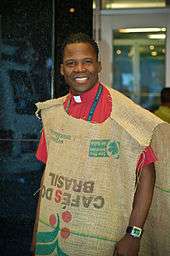Sackcloth


Sackcloth (Hebrew שַׂק saq) is a term originally denoting a coarsely woven fabric, usually made of goat's hair. It later came to mean also a garment made from such cloth, which was chiefly worn as a token of mourning by the Israelites. It was furthermore a sign of submission (1 Kings 20:31-32), or of grief and self-humiliation (2 Kings 19:1),[1] and was occasionally worn by the Prophets.[2] It is often associated with ashes.[3] In Christianity, the tradition of wearing a sackcloth, also known as a hairshirt, continued as a self-imposed means of mortification of the flesh that is often worn during the Christian penetential season of Lent, especially on Ash Wednesday, Good Friday, and other Fridays of the Lenten season.[4][5]
Biblical usage
The 1906 Jewish Encyclopedia says the Old Testament gives no exact description of the garment, so its shape must be a matter of conjecture. According to Adolf Kamphausen, the sacḳ was like a corn-bag with an opening for the head, and another for each arm, an opening being made in the garment from top to bottom. Karl Grüneisen ("Ahnenkultus", p. 80) thought the saḳ resembled the hairy mantle used by the Bedouins. Friedrich Schwally (in Stade's "Zeitschrift", xi. 174) concludes that it originally was simply the loin-cloth, which is an entirely different conception from that of Kamphausen or of Grüneisen. Schwally bases his opinion on the fact that the word "ḥagar" חָגַר (to gird)[6] is used in describing the mode of putting on the garment (see Joshua 1:8; Isaiah 3:24, 15:8, 22:12; Jeremiah 6:26, 49:3). One fastens the sacḳ around the hips ("sim be-motnayim", Genesis 37:34; "he'elah 'al motnayim", Amos 8:10), while, in describing the doffing of the sacḳ, the words "pitteaḥ me-'al motnayim" are used (Isaiah 20:2). According to 1 Kings 21:37 and 2 Kings 6:30, it was worn next the skin.
Schwally assumes that in prehistoric times the loin-cloth was the usual and sole garment worn by the Israelites. In historic times it came to be worn for religious purposes only, on extraordinary occasions, or at mourning ceremonies. It is natural that, under certain circumstances, the prophets also should have worn the sacḳ, as in the case of Isaiah, who wore nothing else, and was commanded by God to don it (Isaiah 20:2). The Jewish Encyclopedia suggests that "old traditions about to die out easily assume a holy character".[7] Thus Schwally points to the circumstance that the Moslem pilgrim, as soon as he puts his foot on Ḥaram, the holy soil, takes off all the clothes he is wearing, and dons the iḥram.
See also
References
- ↑ Pulpit Commentary on 2 Kings 19, accessed 20 January 2018
- ↑ E.g. Isaiah in Isaiah 20:2
- ↑ E.g. Daniel 9:3
- ↑ Jeffrey, David L. (1992). A Dictionary of Biblical Tradition in English Literature. Wm. B. Eerdmans Publishing. p. 673. ISBN 9780802836342.
- ↑ Beaulieu, Geoffrey of; Chartres, William of (29 November 2013). The Sanctity of Louis IX: Early Lives of Saint Louis by Geoffrey of Beaulieu and William of Chartres. Cornell University Press. p. 89. ISBN 9780801469145.
- ↑ "Strong's Hebrew: 2296. חָגַר (chagar) -- to gird, gird on, gird oneself". biblesuite.com.
- ↑ Joseph Jacobs, Wilhelm Nowack, Sackcloth, accessed 20 January 2018
- Much of this article is taken from the article Sackcloth by Joseph Jacobs and Wilhelm Nowack in the 1906 Jewish Encyclopedia, now in the public domain in the United States as a work published before 1923.
- Schwally, Das Leben nach dem Tode (The Life After Death), pp. 11 et seq., Giessen, 1892
| Wikimedia Commons has media related to sackcloth. |